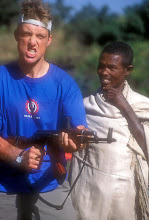
Of all the countries I’ve traveled to, Bhutan was the one that people knew the least about. In fact most people didn’t even know where it was, only a few venturing a correct guess at Asia.

Kayakers of course know Bhutan as the Hidden Kingdom in The Himalaya, The Elite locale of kayaking for a privileged few and the last frontier in Himalayan first Descents. As the only Buddhist state in the world, Bhutan until recently had a policy which closed it from foreigners and tourists. It has now relaxed rules over the last four decades or so to permit a low impact high revenue Visa policy for Tourists. This means annual numbers are capped and Visas are pricey, so it’s hard to access for rat bag kayakers. I was fortunate however, to be invited by Marc Goddard of Bio Bio Expeditions to join as videographer for their Drangme Chhu Expedition in November 09.

Brainchild of chain smoking Kiwi, Dave Allardice, The Drangme Chhu is one of Bhutan’s last great un-run rivers. In an attempt to verify its commercial viability Dave and Marc had collaborated for nearly three years to get the trip up and running. Postponed in 2008 due to Indian insurgent activity on the border at the proposed take out, things had settled in 2009, so with a full batch of rafting guinea pigs and kayakers we landed in Thimpu, Bhutan.
Most capital cities in Asia fill the ears with incessant traffic, the nose with the products of that traffic and sights that range from charming to alarming. So to be in a capital that is peaceful is very welcome, with a population of just under 10,000 (half a million in Bhutan total) Thimpu sets the scene for the experience in Bhutan, tranquil, and surprisingly serene for this part of the world.

As with all river trips there is a combination of driving, hiking, discussion and faff before getting wet. Most of the logistical problems in Bhutan are limited to long drives over never ending passes which are a fantastic way to witness the diversity in ecosystems as the roads charge skyward for hours and then plummet alarmingly back down to valley bottoms again. It took us two days of driving to reach the put in of The Drangme Chhu at Trongsa. And right of the bat, aftershocks from a recent earthquake reinforce the groups ant size insignificance in This Himalayan environment.

Dave is not really sure how long the trip will take but has allotted about 7 days. So after day one of fairly continuous, significant pool drop class 5 we’re concerned about progress as we haven’t even reached the rapids that are marked on the map.
But like life, the journey of a thousand steps begins with the first one and so on day two we push off drifting under the ubiquitous foot bridges lined with Buddhist prayer flags and start breaking the river down one horizon line at a time.

Representative of most Himalayan runs the river evolves into classic pool drop rapids around massive boulders driven South by millenia of Himalayan monsoonal flows. And all is going well, tight lines, good communication and maybe a little luck until midway through the third afternoon. A long boulder field is punctuated by a large ledge hole. After a discussion filled with many different opinions the group decides to send Pierro first, who muscles through it.
He’s followed soon after by Dave, in his paddle boat, with not quite the same results. Catching the edge of the hole with a little angle it re-enters swiftly as it is turned and then violently flipped, raft #2 in the water and Marc on his way. While Marc takes a more central line, a stern mounted Oar frame gives him a little more momentum. Although this carries him through, the hole still wants tribute and so it spins the boat and the paddlers on the upstream edge cartwheel into the water. This is big carnage, one full raft of swimmers disappearing into the pool below which is followed soon after by the next rapid and now Marc trying to save 3 of his team.
This is a serious situation and as trip videographer…I’m delighted.

Needless to say the Bio Bio/ Ultimate Descents safety net swings into action with a combination of Safety Kayakers, cata-rafts and other rafts. The group is safely mopped up before they disappear off down stream, so they can lick their wounds and formulate war stories.
And as our group bonds the river matures from angry and desperate to more languid rapids in pristine Jungle until it finally flattens just shy of the Indian border. Here we jump in Indian Military vehicles to shuttle out into India, along the border and back into Bhutan in a neighboring catchment. And it is this juxtaposition, the franticness of India versus the composure of Bhutan that reminds us the serenity we have witnessed in Bhutan.
We’re back in Bhutan and we love it!
Thanks to Marc, Dave, Larry and Scott Maguire at The North Face.





















